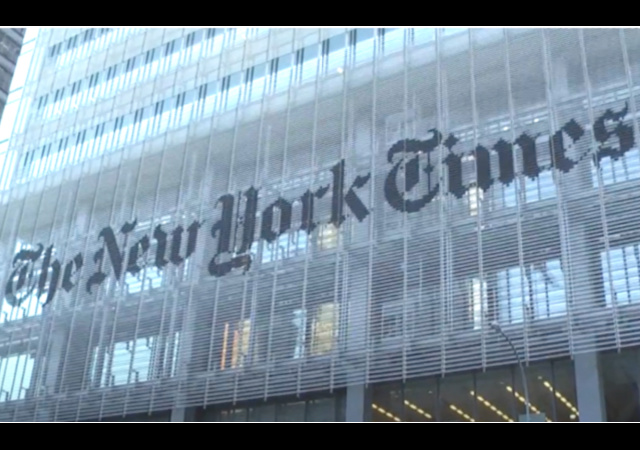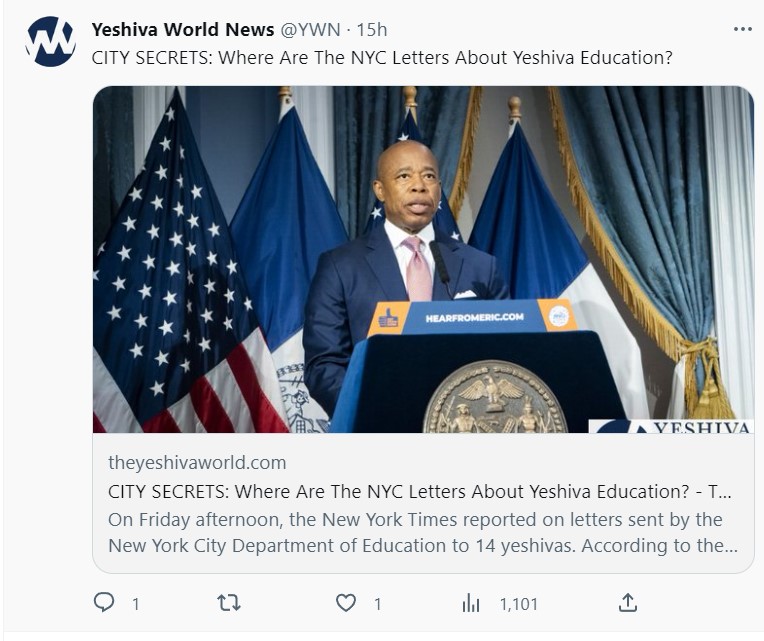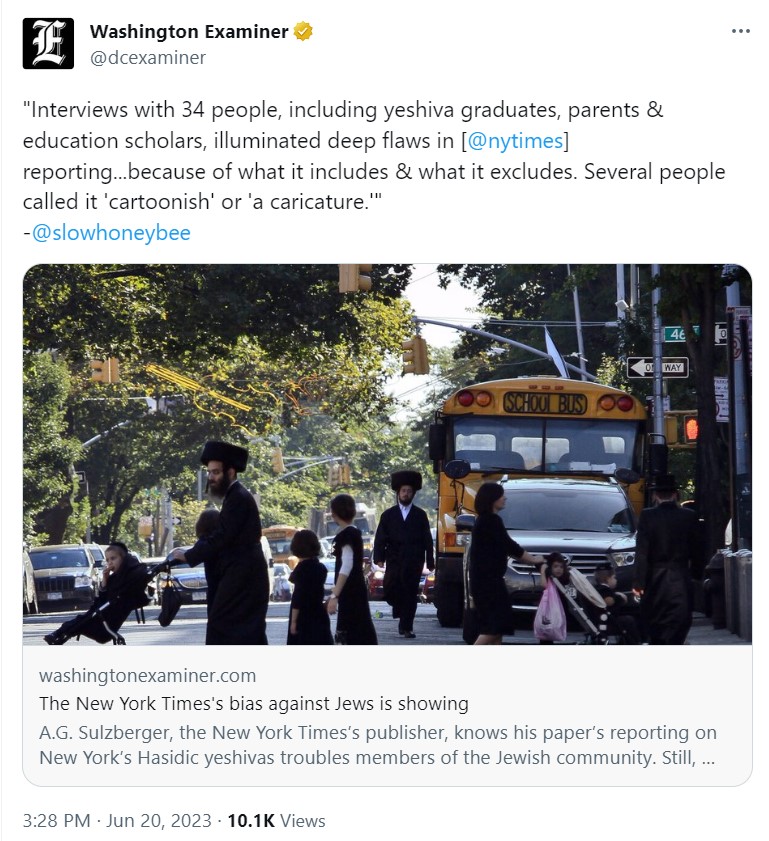NY Times Runs Yet Another Suspiciously-Timed Hit Piece on Hasidic Yeshivas, Casts Them as “Lawbreakers”
NYT dropped the article just before the Sabbath of a holiday weekend, so that those affected could not respond for at least 24 hours.

Another Friday afternoon, another suspiciously timed hit piece on Hasidim by Eliza Shapiro and Brian M. Rosenthal. Those are the two New York Times reporters who’ve made a name for themselves attacking New York’s Orthodox Jewish communities, as we reported here:
- NY Times Hit Piece On Hasidic Education Published On Eve Of NY Regents Vote To Undermine All Religious Schools
- NY Times and WaPo Continue Smear Campaign Against Orthodox Jews As Antisemitic Hate Crimes Surge
The Hasidic schools have been “breaking the law” (emphasis added), the two breathlessly reported this past Friday, shortly before the Sabbath and the July 4th weekend media dead zone.
The reporters were referring to New York City officials’ findings that 18 yeshivas failed to comply with the state “substantial equivalency” regulations for educating their students.
But the Times provided no links to those findings. And the City refused to release them, as of this morning, according to Yeshiva World News, which raised questions about the City’s role in its tweet. Why did the City send the letters to the New York Times while ignoring their requests to see them: “Where Are The NYC Letters About Yeshiva Education?”
Meanwhile, the Times’s accusation would now sink into the public psyche—and Google search results—while those affected held back their response for more than 24 hours.
We covered the controversy over the regulations and their threat to all Orthodox Jewish schools here:
- NY State Proposed Regulations Threaten Orthodox Jewish Schools
- Court Strikes NY State Regulations Threatening Orthodox Jewish Yeshivas Under “Substantial Equivalency” Test
Under the recently adopted regulations, nonpublic schools must submit themselves to review by a local school authority (LSA) readied with a list of “objective criteria”—and the power to determine whether the private school meets them.
From Section 130.9 of the New Regulations:
When reviewing a nonpublic school for substantial equivalency, other than schools deemed substantially equivalent pursuant to section 130.3 of this Part, the following must be considered:
(a) whether instruction is given only by a competent teacher or teachers as required by Education Law §3204(2)(i);
(b) whether English is the language of instruction for common branch subjects as required by Education Law §3204(2)(i);
(c) whether students who have limited English proficiency have been provided with instructional programs enabling them to make progress toward English language proficiency as required by Education Law §3204(2-a);
(d) accreditation materials from the last five years;
(e) whether the instructional program in the nonpublic school as a whole incorporates instruction in mathematics, science, English language arts, and social studies that is substantially equivalent to such instruction required to be provided in public schools pursuant to Education Law §3204(3);
(f) whether the nonpublic school meets the following other statutory and regulatory instructional requirements:
(1) instruction in patriotism and citizenship pursuant to Education Law §801(1) and section 100.2(c)(1) of this Title;
(2) instruction in the history, meaning, significance and effect of the provisions of the Constitution of the United States and the amendments thereto, the Declaration of Independence, the Constitution of the State of New York and the amendments thereto, pursuant to Education Law §801(2) and section 100.2(c)(3) of this Title;
(3) instruction in New York State history and civics pursuant to Education Law §3204(3) and section 100.2(c)(7) of this Title;
(4) instruction in physical education and kindred subjects pursuant to Education Law §803(4) and section 135.4(b) of this Title and instruction in health education regarding alcohol, drugs, and tobacco abuse pursuant to Education Law §804 and section 100.2(c)(4) of this Title. Pursuant to Education Law §3204(5), a student may, consistent with the requirements of public education and public health, be excused from such study of health and hygiene as conflicts with the religion of the students’ parents or guardian; provided that such conflict must be certified by a proper representative of their religion as defined in Religious Corporations Law §2;
(5) instruction in highway safety and traffic regulation, pursuant to Education Law §806 and section 100.2(c)(5) of this Title;
(6) instruction in fire drills and in fire and arson prevention, injury prevention and life safety education, pursuant to Education Law §§807 and 808, and section 100.2(c)(6) of this Title; and
(7) instruction in hands-only cardiopulmonary resuscitation and the use of an automated external defibrillator pursuant to Education Law §305(52) and section 100.2(c)(11) of this Title; and
(g) For nonpublic schools meeting the criteria in Education Law §3204(2)(ii)-(iii), the criteria enumerated in such statute for such schools.
The Times called the findings that the yeshivas had failed to meet these standards an “extraordinary rebuke” and congratulated itself on the win:
The action by the city follows reporting by The New York Times that found that scores of all-boys Hasidic schools in Brooklyn and the lower Hudson Valley had denied their students an adequate secular education, and that teachers in some of the schools had used corporal punishment to enforce order.
But that reporting has since been roundly criticized for its lack of journalistic integrity and accuracy, most recently in a carefully documented rebuttal by Melissa Braunstein at the Washington Examiner. Her report included “interviews with 34 people, including yeshiva graduates, parents and education scholars” and “illuminated deep flaws in [@nytimes] reporting,” the paper said in a later tweet:
Despite this, the New York Times’s latest attack doubles down on its disregard for the truth. In a legerdemain, Shapiro and Rosenthal accuse the yeshivas of “breaking the law” three times, not including the caption to the article. And the title of the print version: “Many Yeshivas Breaking Law, City Concludes.”
Breaking the law? If you read her opinion closely, that’s not what New York State Supreme Court Justice Christina Ryba said this past March when she struck down the new regulations requiring parents to withdraw their children from yeshivas that are not up to regulatory snuff. Those provisions would have effectively forced closure of the schools themselves.
As we wrote here, such dire consequences, the court held, are “above and beyond” what is authorized under the state’s Compulsory Education Law.
Instead, the court held, when a nonpublic school falls short of the new criteria:
[T]he parents should be given a reasonable opportunity to prove that the substantial equivalency requirements for their children’s education are satisfied by instruction provided through a combination of sources. For example, parents should be permitted to supplement the education that their children receive at a nonpublic school with supplemental instruction that specifically addresses any identified deficiencies in that education, such as by providing supplemental home instruction.
That means the state can’t shut down the noncompliant yeshivas. It means the parents can still send their kids there, whether the school meets the state’s standards or not.
And that is because, as the court made clear, it is the parents’ prerogative—and duty—to keep their children in the nonpublic school of their choosing, even where it fails to meet the criteria, and supplement their education through other resources, including homeschooling.
Shapiro and Rosenthal tuck away the judge’s ruling in one sentence admitting the state’s rules “were further weakened earlier this year when a judge hearing a lawsuit brought by some yeshivas ruled that the state could not close schools for being noncompliant.” Ignoring the totality of the decision—a judge was just doing some things—they cast those noncompliant yeshivas as “lawbreakers.”
But the court did not merely “weaken” the regulations as applied to schools. In fact, it could not have been more clear in rejecting them. It found:
that 8 NYCRR 130.6 [ c] [2] [i] and 8NYCRR 130.8 [ d] [7] [i]– stating that “the nonpublic school shall no longer be deemed a school which provides compulsory education fulfilling the requirements of Article 65 of the Education Law” – – must be stricken.
Consequently, as the Agudath Israel of America, a plaintiff in the lawsuit, said in its statement today: “Government bureaucrats have no authority to penalize nonpublic schools for not conducting their classrooms in a manner that is substantially equivalent to public schools, as the state imposes.”
The Times reporters do, to be fair, in light of the judge’s ruling, acknowledge that the law is unclear as to what “consequences the schools might face if they do not commit to improving.”
Still, the question remains: Is failure to meet a regulatory requirement the same as “breaking the law”? Judge Ryba’s methodic opinion suggests otherwise. Besides, by that standard, an awful lot of New York City public schools are likely “breaking the law.”
While it might seem a fine point, the Times’s message is their mission: Orthodox Jews flout the rules and game the system. Shapiro and Rosenthal have been driving that old trope home for months on end, and this latest eve-of-Sabbath-news-dump shows they have no plans on stopping.
If they did, they would admit that the real “extraordinary rebuke”—calling the state on its administrative power grab—came from the judge.
 DONATE
DONATE
Donations tax deductible
to the full extent allowed by law.










Comments
The NYT may want to climb down off their high horse. ‘Breaking the law’ is distinct from violating a regulation but if they insist let’s see their expose on NYC public schools compliance with all applicable regulations. Just for an accurate contrast of course. It’s totes not that the comparative lack of interest on the part of the NYT to deep dives into the shortfalls of NYC public schools is at all noticeable. /s
Imus on air used to call staff members at home on holidays when they were forbidden to answer the phone. Maybe the NYT learned it there. The staffers usually answered though. The religious part was taking off work.
You cannot win a Pulitzer if you do not use journalism to create false narratives to mislead readers into adopting false impressions of the reality, for the benefit of the Establishment.
You could point out to the school board what Tom Hanks said in Bridge of Spies (2015), as a lawyer for the Russian spy asked to rat him out to the FBI, on what you need to teach citizenship:
You’re agent Hoffman, yeah?
Yeah.
German extraction?
Yeah, so?
My name is Donovan, Irish. Both sides, mother and father. I’m Irish, you’re German, but what makes us both Americans? Just one thing, one one one. The rule book. We call it the Constitution. We agree to the rules, and that’s what makes us Americans, it’s all that makes us Americans. So don’t tell me there’s no rule book and don’t nod at me like that you sonofabitch.
Do we need to worry about you?
Not if I’m left alone to do my job.
One thing you can count on with the New Dork Times is it’s always on the wrong side of history.
They are only on the wrong side of the “first draft of history” once they get a chance to rewrite it they were right all along.
One of my favorite bloggers refers to the NYT as the flagship of the “Duranty-Streicher Media.” And clearly they are re-earning that badge every day.
I assume that the authors of this hit piece, Shapiro and Rosenthal, are Jewish — at least in heritage, if not in actual practice. But, their affinity for and fealty towards Judaism and Jews appears to be about as enthusiastic as that of George Soros.
The vile Dhimmi-crats have trained their acolytes well and they’ve made it be known that you can’t be a member of the “cool kids,” unless you vilify and denigrate Jews and Israel.
JINOs. Jewish in name only.
.
{SARC}
I’m shocked, SHOCKED I tell you, to learn that the New York Times would do something so patently dishonest.
{/SARC}
Sure, buddy. Like you’d know a Jew if you ran right into one.
Speaking of the NYT, did anyone see yesterday’s hitpiece against July 4th?
https://archive.is/l2QIT
It looks like some of the people interviewed miss the point of the holiday: That the original colonies declared independence from an oppressive government so they could determine their own future and the path to approach it. If that point is kept in mind, it’s easier to understand what it’s supposed to mean.
.
I wonder if our local Amish schools even have AEDs, much less provide instruction in how to use them…
When I was a kid, we had mules do it.
This is the anti Orthodox narrative of the NYT in full display
This is the same organization that fronted for mass-murderer Stalin.
How ‘The New York Times’ Helped Hide Stalin’s Mass Murders in Ukraine:
https://www.tabletmag.com/sections/arts-letters/articles/walter-duranty-ukraine-new-york-times-mr-jones-agnieszka-holland
Where on G-d’s green earth is Milstein?
Before passing judgement, I urge you to take a hard look at what’s happening between the ultra-orthodox and secular communities in Orange and Rockland counties in New York – especially in the East Ramapo school district. These areas have among the highest welfare, food stamp, and public assistance rates in the country. Hasidic communities including the incorporated villages of Kiryas Joel, Kaser, and New Square are completely self-segregated – potential non-Orthodox residents need not apply.
Many (not all) of of the adult population in the ultra-orthodox community – especially men – are unable to function in general society in the US because their education focuses almost exclusively on studying the Torah, and doesn’t include sufficient emphasis on other subjects (such as English, math, etc). Although the Yeshivas are considered private schools, they receive substantial taxpayer funding.
The hit piece spills out that the “failings” are in English and social science, ie. they don’t promote the DEI, LGBT+ indoctrination. The students from Yeshiva function fully in society as do all the members of the community. They operate businesses, don’t commit crime and mind their own lives without bothering anyone. Why attack the Jewish students unless you’re deflecting that the secular students in public schools aren’t doing better? Any recognition of public education failing? Nope, blame the Jews. Whether the Yeshivas get a public benefit or not, their students in the classrooms each day, are fully literate and understand science and math better than the students from any public school in NYC. The state of NY has more than 20,000 Amish residents. Is there concern for their education? They don’t attend school after 8th grade. How many people think they would test proficiently at 6th grade level adequately?
Does the NYT have anything to say about madrassas?
Asking for a friend.
“…provided that such conflict must be certified by a proper representative of their religion as defined in Religious Corporations Law §2;”
How does this pass Constitutional muster?
Hasidic Jews are very law-abiding – but they obey God’s law, not the fashion of the moment in Albany.